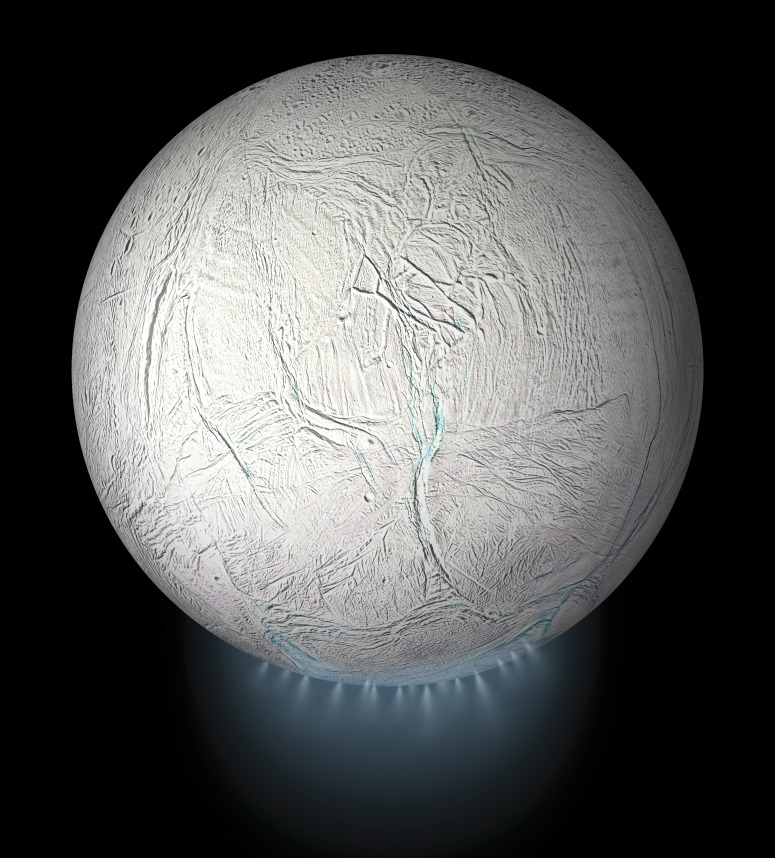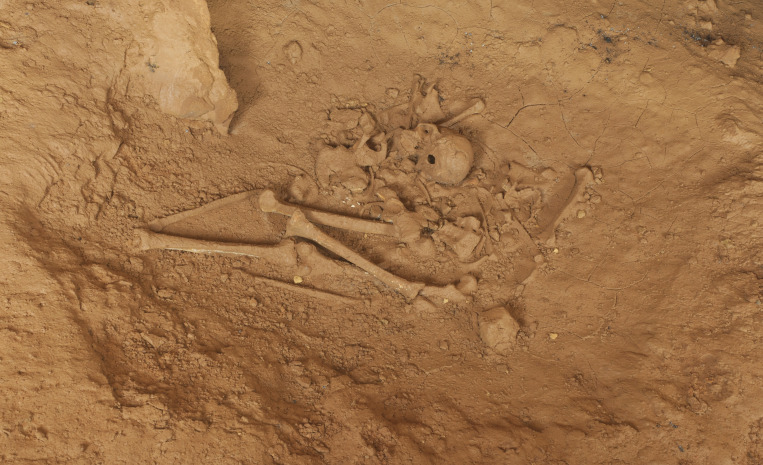Ice shell asymmetry and geyser formation on Enceladus
Enceladus. Image credit: NASA/JPL-Caltech.
Beneath the icy shell that encases Enceladus, one of Saturn’s small icy moons, an ocean of liquid water ejects geyser-like sprays into space through fissures in the ice. All the geysers on Enceladus are clustered near the moon’s south pole—a thermodynamic asymmetry between the north and south poles that remains unexplained. Noting that current theories largely build on preexisting asymmetry, such as a large impact, Wanying Kang and Glenn Flierl (pp. 14764–14768) report an idealized model of ice shell evolution, showing that significant hemispheric differences in ice shell thickness can evolve naturally over millions of years from an early, infinitesimal random perturbation. The authors also applied the model to calculate the specific range of conditions needed to break away from symmetrical ice growth. The conditions, when applied to the icy moons of Saturn and Jupiter, equate to a conductive ice shell, the thickness of which is in the range of 10–30 kilometers. The findings demonstrate that symmetrical ice shell evolution is not a stable equilibrium and that, under certain conditions, the surface can develop large-scale topography, according to the authors. — T.J.
How canyons evolve
Panoramic view of Rainbow Canyon emptying into Panamint Valley in the distance.
Canyons are deep, narrow valleys carved by rivers and characterized by steep slopes. Li Zhang et al. (pp. 14730–14737) developed a morphodynamic model to uncover insights into how rivers incise tablelands and form canyons over time. The authors considered factors including abrasion of the riverbed by sediment and contribution of sediment from upriver alluvial sources and sidewall erosion. The model also included migration of the headwall of the canyon upstream. The headwall represents a type of knickpoint, a change in slope attributable to differential erosion between the upriver alluvial sediment and the downriver bedrock. The model predicts that alluvial sources are likely to have a lower slope than the bedrock. The authors applied the model to Rainbow Canyon near California’s Death Valley and found that, like most canyons, Rainbow Canyon has a shallow slope above the headwall. The model indicates that the difference in slope is inversely proportional to the migration rate of the headwall, suggesting that Rainbow Canyon’s headwall took 120,000 years to reach its current position. According to the authors, the model provides a template for predicting long-term canyon incision, sidewall erosion, and canyon extension into the uplands in tectonically active terrain prone to canyon formation. — T.H.D.
Paleolithic mortuary rituals
Disarticulated skeletal remains of an adult male deposited in a bear nest.
Around 30,000 years ago, before the Last Glacial Maximum, the Gravettian culture was known for its prolific cave art, Venus figurines, and elaborate burials. Sacha Kacki, Sébastien Villotte, et al. (pp. 14851–14856) describe the details and dynamics of burials at the Grotte de Cussac, a cave discovered 20 years ago in southwestern France. The authors used photographs and 3D photogrammetric models owing to restrictions on direct contact with cave surfaces or remains. In one area deep in the cave, the authors observed a complete male skeleton in the shallow bowl-like depression of a former bear nest and bones from at least two individuals sorted anatomically in other former nests. Additionally, the authors observed bones from at least three individuals sorted into hollows along the wall. The bones appeared to be sorted roughly by lower and upper anatomy. The authors report that the burial sites at Cussac were farther inside the cave than is typical. The authors also found elaborate cave art, with more than 800 engravings—another feature unusual for burial sites. According to the authors, the mortuary practices at Cussac offer rich insight into the social diversity and complex interactions between the living and the dead in this foraging culture. — T.H.D.
State laws and firearm mortality
Approximately 39,000 individuals in the United States die annually from firearm injuries. Although several states have passed laws regulating firearm storage or use, it is unclear how such laws affect the number of firearm-related deaths. Terry Schell et al. (pp. 14906–14910) reviewed three classes of gun laws: child access prevention (CAP) laws regulating how firearms can be stored, right-to-carry (RTC) laws making it easy to carry concealed firearms, and stand your ground (SYG) laws limiting the legal liability of individuals who use firearms in self-defense. The authors examined how the laws were associated with state-level changes in firearm deaths from 1980 to 2016 in the United States. Six years after enactment, CAP laws were associated with reduced firearm-related deaths, whereas RTC and SYG laws were associated with small increases in firearm-related deaths. States with the most restrictive policies, in which a CAP law but no RTC or SYG law was enacted, were estimated to have 11% fewer firearm deaths than states with the least restrictive policy combination. Nationwide, a reduction of this size corresponded to an estimated 4,475 fewer firearm deaths per year. The findings suggest that policies restricting how individuals store or use firearms may reduce the number of firearm-related deaths, according to the authors. — M.S.
Dynamics of sitting
Sitting for prolonged periods has significant impacts on physical and mental health. Pam ten Broeke et al. (pp. 14883–14889) analyzed the dynamics of individuals’ postural transitions during the workday to help inform interventions aimed at preventing unhealthy sitting. The authors examined sitting behavior, which is usually measured as total time spent sitting on a daily basis, on a granular level by observing the timing of transitions from sitting to standing and vice versa. The authors observed 156 workers who wore activPAL monitors, which measure body position. Over the course of 7 days, the authors recorded 30,000 postural shifts of the study participants, who primarily performed desk work, during the workday. Overall, participants tended to switch postures later in the workday, suggesting that behavioral interventions should be directed toward the beginning of the day. Participants were more likely to stand if they had been active in recent hours; however, switching postures was not associated with physical fitness levels. The authors note that the health consequences of sitting affect even individuals with sufficient daily physical exercise. According to the authors, sitting for prolonged periods might come to be perceived as an occupational hazard, similar to exposure to toxins or excessively loud noise. — T.H.D.
Wild hummingbirds see nonspectral colors
Color perception plays a critical role in foraging, mate choice, and predator avoidance. However, how birds and other vertebrates with more than three types of color-sensitive retinal receptors, called cones, perceive nonspectral colors remains unclear. Mary Caswell Stoddard et al. (pp. 15112–15122) performed field experiments on wild broad-tailed hummingbirds, which have four cone types. Using a custom light-emitting diode device, the authors displayed two different colors on circular surfaces next to hummingbird feeders containing either a reward, namely a sucrose solution, or water. By tracking preferential visits to the reward-associated feeder, the authors found that the hummingbirds could distinguish nonspectral colors, such as ultraviolet plus red, from their pure components, such as ultraviolet and red. Additional analysis of 965 bird plumage and 2,350 plant measurements revealed that approximately 30% of plumage colors and 35% of plant colors are nonspectral to hummingbirds. Taken together, the findings suggest that wild hummingbirds can perceive a variety of nonspectral colors, accessing a rich color space that might play a previously underappreciated role in communication and foraging. According to the authors, the findings could have broad implications for understanding color vision in the animal world. — J.W.





